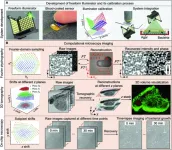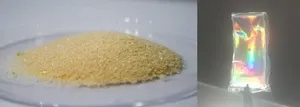(Press-News.org) Seeking to expand the possibilities offered by programmable illumination, a group of researchers at the University of Connecticut developed a strategy for constructing and calibrating freeform illuminators offering greater flexibility for computational microscopy. Their calibration method uses a blood-coated sensor for reconstruction of light source positions. They demonstrated the use of calibrated freeform illuminators for Fourier ptychographic microscopy, 3D tomographic imaging and on-chip microscopy and used a calibrated freeform illuminator in an experiment to track bacterial growth.
The group’s research was published Feb. 20 in Intelligent Computing, a Science Partner Journal.
New possibilities for experimental setup using freeform illumination allow not only more flexibility but also greater efficiency: “With this platform, we can start to transit Petri-dish-based experiments from the traditional labor-intensive process to an automated and streamlined process,” the research paper states.
Programmable light sources simplify the work of illuminating samples in different kinds of microscopy contexts, but conventional programmable arrays consist of a flat, fixed grid of individual lights. An array consisting of lights that can be placed anywhere in three dimensions offers experimenters the opportunity to reduce the size of the illuminator, to place the lights closer to the sample, and to increase the density of the lights and adjust the angle of illumination according to their specific requirements.
Freeform illumination can be further enhanced in the future with better calibration methods, denser lighting arrangements, lights with a greater diversity of wavelengths and adjusted position estimates.
The authors designed and built four different freeform illuminators: a tilted flat surface, a triangular pyramid, a dome and a Mobius band. The pyramid illuminator had several advantages. It was angled towards the sample, it had the highest number of lights at the point farthest from the sample and it could be placed very close to the sample to deliver light efficiently.
The authors calibrated the illuminators using a blood-coated sensor. Coating the sensor with a thin but dense layer of particles enabled the authors to calculate the position of each lighting element using ray tracing. The advantage of using human blood from a finger prick is that no sophisticated or expensive tools are needed. However, other substances with similar properties can be used in its place. The authors verified their calibration method, finding that the recovered positions matched the actual positions with only small deviations.
The authors demonstrated the use of their freeform illuminators in several experiments. All four illuminators were used successfully for Fourier ptychographic microscopy, a computational microscopy technique that combines different images produced with lighting at varying angles.
The pyramid illuminator was used to capture separate images lit with red, green and blue light which were combined to make a full-color image. It was also used for 3D tomography, a technique that builds a 3D image by stacking cross-section images of a 3D sample.
The pyramid illuminator was used for on-chip microscopy, a setup where the sample sits directly on the sensor, just like the blood smear in the calibration step. Combining the images produced with separate lights in the freeform illuminator results in a final image with higher resolution than any of the raw images alone, which is why this technique is called super-resolution microscopy. One experiment produced a still image of blood cells, and another produced a time-lapse series of the growth of a colony of E. Coli bacteria on a block of agar.
Guoan Zheng conceived the idea and designed the experiments. Pengming Song and Tianbo Wang conducted the experiments. Their co-authors on this paper are Shaowei Jiang, Chengfei Guo, Ruihai Wang, Liming Yang and You Zhou.
END
Smaller, denser, better illuminators for computational microscopy
Blood-coated sensor enables flexible illumination design
2023-03-22
ELSE PRESS RELEASES FROM THIS DATE:
Binghamton University reaches highest ever score for LGBTQ+ inclusion
2023-03-22
BINGHAMTON, N.Y. -- Binghamton University, State University of New York scored a nearly perfect ranking on the latest national Campus Pride Index, which measures a university’s commitment to LGBTQ+ safety and inclusivity on campus. The University received a 4.5 out of 5, an increase from the 3.5 scores received in previous years.
Nicholas Martin, assistant director of the LGBTQ Center at Binghamton University, sees this as a reflection of the organization’s dedication and Binghamton’s real commitment to outreach.
“Our ...
Researchers make biodegradable optical components from crab shells
2023-03-22
WASHINGTON — Researchers have developed a process to turn crab shells into a bioplastic that can be used to make optical components known as diffraction gratings. The resulting lightweight, inexpensive gratings are biodegradable and could enable portable spectrometers that are also disposable.
“The Philippines is known for delicious seafood, but this industry is also a source of large amounts of solid waste such as discarded crab shells,” said research team leader Raphael A. Guerrero, from Ateneo de Manila University in the Philippines. “We wanted to find an alternative use for crab shell ...
Beethoven’s genome offers clues to composer’s health and family history
2023-03-22
University of Cambridge Media Release
Beethoven’s genome offers clues to composer’s health and family history
UNDER STRICT EMBARGO UNTIL 11:00 US ET / 15:00 UK / 16:00 CET ON WEDNESDAY 22nd MARCH 2023
International team of scientists deciphers renowned composer’s genome from locks of hair.
Study shows Beethoven was predisposed to liver disease, and infected with Hepatitis B, which – combined with his alcohol consumption – may have contributed to his death.
DNA ...
Ludwig von Beethoven’s genome sheds light on chronic health problems and cause of death
2023-03-22
In 1802, Ludwig van Beethoven asked his brothers to request that his doctor, J.A. Schmidt, describe his malady—his progressive hearing loss—to the world upon his death so that "as far as possible at least the world will be reconciled to me after my death." Now, more than two centuries later, a team of researchers reporting in the journal Current Biology on March 22 have partially fulfilled his wish by analyzing DNA they lifted and pieced together from locks of his hair.
“Our primary goal was to shed light on Beethoven’s health problems, which famously include progressive hearing loss, beginning in his mid- to late-20s and eventually leading to him ...
Unusual Toxoplasma parasite strain killed sea otters and could threaten other marine life
2023-03-22
Scientists in California are raising the alarm about a newly reported form of toxoplasmosis that kills sea otters and could also infect other animals and people. Although toxoplasmosis is common in sea otters and can sometimes be fatal, this unusual strain appears to be capable of rapidly killing healthy adult otters. This rare strain of Toxoplasma hasn’t been detected on the California coast before, and may be a recent arrival, but scientists are concerned that if it contaminates the marine food chain it could potentially pose a public health risk.
“I have studied Toxoplasma infections in sea otters for 25 years — I have never ...
Sea otters killed by unusual parasite strain
2023-03-22
Four sea otters that stranded in California died from an unusually severe form of toxoplasmosis, according to a study from the California Department of Fish and Wildlife and the University of California, Davis. The disease is caused by the microscopic parasite Toxoplasma gondii. Scientists warn that this rare strain, never previously reported in aquatic animals, could pose a health threat to other marine wildlife and humans.
The preliminary findings, published in the journal Frontiers in Marine Science, note that toxoplasmosis is common in sea otters and can be fatal. This unusual strain appears to be especially virulent and capable of rapidly killing healthy adult otters.
The ...
Prevalence of statin use for primary prevention of atherosclerotic cardiovascular disease by race, ethnicity, 10-year disease risk
2023-03-22
About The Study: Statin use for primary prevention of atherosclerotic cardiovascular disease (ASCVD) was low among all race and ethnicity groups regardless of ASCVD risk, with the lowest use occurring among Black and Hispanic adults in this study of survey data representing 39.4 million adults. Improvements in access to care may promote equitable use of primary prevention statins in Black and Hispanic adults.
Authors: Joshua A. Jacobs, Pharm.D., of the Spencer Fox Eccles University of Utah School of Medicine in Salt Lake City, and Ambarish Pandey, M.D., of the University of Texas Southwestern Medical Center in Dallas, are the corresponding authors.
To ...
Cost-effectiveness of mailed home-based HPV self-sampling kits for cervical cancer screening
2023-03-22
About The Study: In this analysis involving 19,000 female participants, mailing human papillomavirus (HPV) self-sampling kits to women overdue for cervical cancer screening was cost-effective for increased screening uptake relative to usual care. These results support mailing HPV kits as an efficient outreach strategy for increasing screening rates among eligible women in U.S. health care systems.
Authors: Richard T. Meenan, Ph.D., M.P.H., M.B.A., of Kaiser Permanente Northwest in Portland, Oregon, is the corresponding author.
To access the embargoed study: Visit our For The Media website at this link ...
Sweets change our brain
2023-03-22
Chocolate bars, crisps and fries - why can't we just ignore them in the supermarket? Researchers at the Max Planck Institute for Metabolism Research in Cologne, in collaboration with Yale University, have now shown that foods with a high fat and sugar content change our brain: If we regularly eat even small amounts of them, the brain learns to consume precisely these foods in the future.
Why do we like unhealthy and fattening foods so much? How does this preference develop in the brain? "Our tendency to eat high-fat and high-sugar foods, the so-called Western diet, could be innate or develop as a result of being overweight. But we think that the brain learns this preference," ...
Study determines most effective ways for hospitals to reduce medication errors
2023-03-22
A new study from researchers from Brigham and Women’s Hospital, a founding member of the Mass General Brigham healthcare system, has shed new light on the best strategies hospitals can use for medication reconciliation, the critical and difficult task of updating and verifying a patient’s medication lists and orders, regardless of where they are in the health care system. The study, published in BMJ Quality and Safety, is a new analysis of data from the second Multi-center Medication Reconciliation ...
LAST 30 PRESS RELEASES:
Numbers in our sights affect how we perceive space
SIMJ announces global collaborative book project in commemoration of its 75th anniversary
Air pollution exposure and birth weight
Obstructive sleep apnea risk and mental health conditions among older adults
How talking slows eye movements behind the wheel
The Ceramic Society of Japan’s Oxoate Ceramics Research Association launches new international book project
Heart-brain connection: international study reveals the role of the vagus nerve in keeping the heart young
Researchers identify Rb1 as a predictive biomarker for a new therapeutic strategy in some breast cancers
Survey reveals ethical gaps slowing AI adoption in pediatric surgery
Stimulant ADHD medications work differently than thought
AI overestimates how smart people are, according to HSE economists
HSE researchers create genome-wide map of quadruplexes
Scientists boost cell "powerhouses" to burn more calories
Automatic label checking: The missing step in making reliable medical AI
Low daily alcohol intake linked to 50% heightened mouth cancer risk in India
American Meteorological Society announces Rick Spinrad as 2026 President-Elect
Biomass-based carbon capture spotlighted in newly released global climate webinar recording
Illuminating invisible nano pollutants: advanced bioimaging tracks the full journey of emerging nanoscale contaminants in living systems
How does age affect recovery from spinal cord injury?
Novel AI tool offers prognosis for patients with head and neck cancer
Fathers’ microplastic exposure tied to their children’s metabolic problems
Research validates laboratory model for studying high-grade serous ovarian cancer
SIR 2026 delivers transformative breakthroughs in minimally invasive medicine to improve patient care
Stem Cell Reports most downloaded papers of 2025 highlight the breadth and impact of stem cell research
Oxford-led study estimates NHS spends around 3% of its primary and secondary care budget on the health impacts of heat and cold in England
A researcher’s long quest leads to a smart composite breakthrough
Urban wild bees act as “microbial sensors” of city health.
New study finds where you live affects recovery after a hip fracture
Forecasting the impact of fully automated vehicle adoption on US road traffic injuries
Alcohol-related hospitalizations from 2016 to 2022
[Press-News.org] Smaller, denser, better illuminators for computational microscopyBlood-coated sensor enables flexible illumination design






